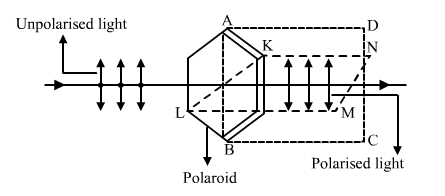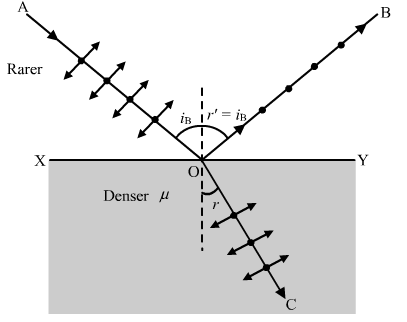 Long Answer Type
Long Answer Type(a) (i) 'Two independent monochromatic sources of light cannot produce a sustained interference pattern'. Give reason.
(ii) Light waves each of amplitude 'a' and frequency 'ω', emanating from two coherent light sources superpose at a point. If the displacements due to these waves is given by y1 = a cos ωt and y2 = a cos(ωt + ϕ) where ϕ is the phase difference between the two, obtain the expression for the resultant intensity at the point.
(b) In Young's double slit experiment, using monochromatic light of wavelength λ, the intensity of light at a point on the screen where path difference is λ, is K units. Find out the intensity of light at a point where path difference is λ/3.
(a) How does one demonstrate, using a suitable diagram, that unpolarized light when passed through a Polaroid gets polarized?
(b) A beam of unpolarized light is incident on a glass-air interface. Show, using a suitable ray diagram, that light reflected from the interface is totally polarized, when μ = tan iB, where μ is the refractive index of glass with respect to air and iB is the Brewster's angle.
Polarization of light is referred to as restricting the vibration of light in a perpendicular direction perpendicular to the direction of propagation of wave.
The vibration of particles of light which is parallel to the axis of crystal passes through the Polaroid on passing an unpolarized light. All other vibrations are absorbed and that is why intensity of emerging light is reduced.
The plane of vibration here is ABCD, in which the vibrations of the polarized light is confined and the plane KLMN is called plane of polarization. KLMN is perpendicular to the plane of vibration.
Reflected light is totally polarized, when unpolarized light is incident on the glass-air interface at the Brewster angle iB. This is known as Brewster’s law.
The reflected component OB and refracted component OC are mutually perpendicular to each other, when light is incident at Brewster’s angle.

Now, using Snell’s law, we have

i = iB and r = (900 – iB)
Therefore,
(a) State briefly the processes involved in the formation of p-n junction explaining clearly how the depletion region is formed.
(b) Using the necessary circuit diagrams, show how the V-I characteristics of a p-n junction are obtained in
(i) Forward biasing
(ii) Reverse biasing
How these characteristics are made use in rectification?
(a) Differentiate between three segments of a transistor on the basis of their size and level of doping.
(b) How is a transistor biased to be in active state?
(c) With the help of necessary circuit diagram, describe briefly how n-p-n transistor in CE configuration amplifies a small sinusoidal input voltage. Write the expression for the ac current gain.